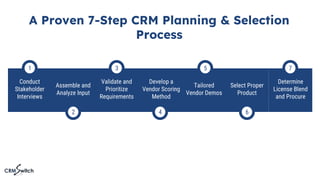7-Step CRM Planning & Selection Process.pptx
- 1. A Proven 7-Step CRM Planning & Selection Process Conduct Stakeholder Interviews Assemble and Analyze Input Validate and Prioritize Requirements Develop a Vendor Scoring Method Tailored Vendor Demos 1 Select Proper Product Determine License Blend and Procure 7 2 3 4 5 6
- 2. "For us, it was not simply a matter of making a decision between a couple of market leading CRM solutions. CRM Switch helped us define our CRM strategy and work through getting all stakeholders on board with the forthcoming changes. "Luckily, they also had a terrific grasp of the manufacturing industry and helped us identify where processes could be improved and efficiencies gained. I highly recommend CRM Switch to any manufacturing company that wants expert guidance in moving to new CRM software." -Jeff Crossley, Director of IT, Labconco
- 3. ŌŚÅ Determine who the key stakeholders are ŌŚÅ Interview the stakeholders ŌŚÅ Interview representative end users if needed ŌŚÅ Capture pain points and requirements ŌŚÅ Cultivate a pride of authorship ŌŚÅ Identify customer interaction touch points 1. Conduct Stakeholder Interviews
- 4. 2. Assemble and Analyze Input (25 - 50 ║▌║▌▀Żs)
- 5. 3. Validate and Prioritize Input (Workshop) Ō£ō Present findings to stakeholders Ō£ō Discuss open issues and clarify ambiguous points Ō£ō Introduce any additional requirements Ō£ō Prioritize key, functional requirements Ō£ō Determine the list of potential CRM vendors
- 6. 4. Develop a Vendor Ranking System Functionality and use case oriented Ō×ó Business process automation tools Ō×ó Ease of searching for specific info Ō×ó System responsiveness Ō×ó Mobile device compatibility Ō×ó Management reporting design tools Ō×ó Email client compatibility Ō×ó ERP integration Ō×ó Usability
- 7. 5. Schedule Tailored Vendor Demonstrations ŌŚÅ Assign individual to chair the presentations ŌŚÅ Determine whether and where clear proof is needed ŌŚÅ Pre-brief the vendor salesperson and SE ŌŚÅ Ensure demos are requirements focused ŌŚÅ Schedule presentations in rapid succession ŌŚÅ Gather additional info requested by vendors
- 8. 6. Select the Best Long Term Solution Ō×ó Review vendor ranking results Ō×ó Follow up questions for vendors Ō×ó Make a final vendor selection Ō×ó Determine your implementation strategy Ō×ó Develop an implementation timeline
- 9. 7. Negotiate and Procure ŌŚÅ Decide on your initial CRM user count ŌŚÅ Determine optimum license blend ŌŚÅ Decide on the duration of your contract ŌŚÅ Determine the subscription start date ŌŚÅ Request any additional functionality
- 10. The Relative Cost of a Structured CRM Buying Process Based on 50 users, three year time horizon. View the spreadsheet Expense Amount 1. Structured CRM Buying Process $17,500 2. Core CRM Subscription $180,000 3. Add-on Product Subscription $36,000 4. Implementation (One Time) $50,000 5. CRM Administrator Salary $81,000 6. Post Implementation Modifications $45,000 Total $409,500
- 11. "We recently had the pleasure of working with Daryn Reif of CRM Switch who helped us evaluate, rank and ultimately select a CRM tool to best fit our growing needs. In CRM Switch, we found the perfect partner. I canŌĆÖt recommend them highly enough." -Janet Babiarz, Gamma Technologies
- 12. Contact Us
Editor's Notes
- #13: For more information, visit us at https://crmswitch.com












